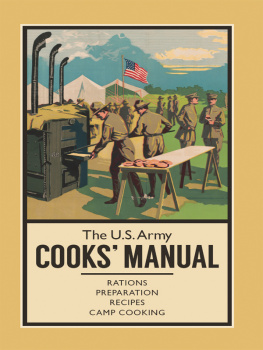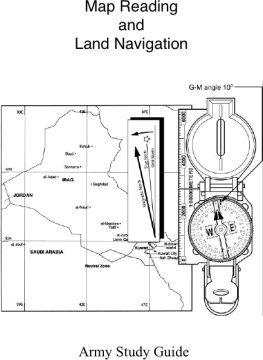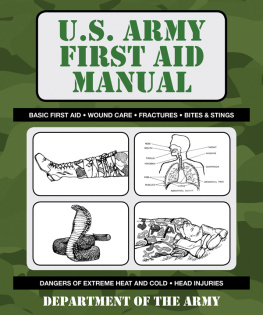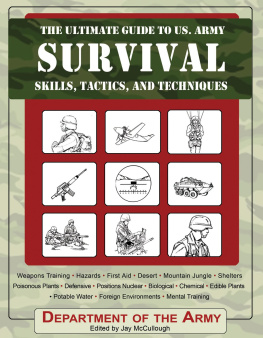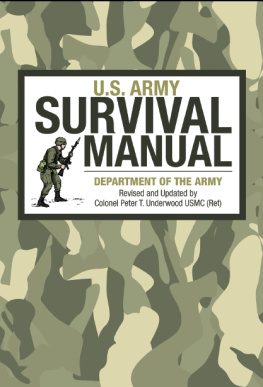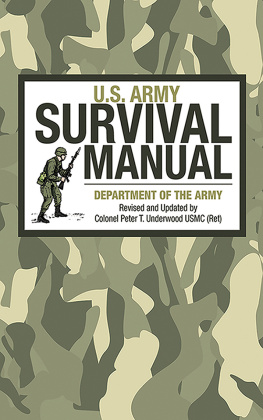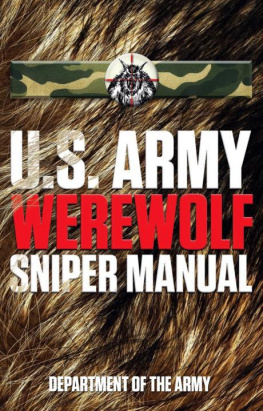Dept of the army - The Official U.S. Army Tactics Field Manual
Here you can read online Dept of the army - The Official U.S. Army Tactics Field Manual full text of the book (entire story) in english for free. Download pdf and epub, get meaning, cover and reviews about this ebook. year: 2019, publisher: Lyons Press, genre: Romance novel. Description of the work, (preface) as well as reviews are available. Best literature library LitArk.com created for fans of good reading and offers a wide selection of genres:
Romance novel
Science fiction
Adventure
Detective
Science
History
Home and family
Prose
Art
Politics
Computer
Non-fiction
Religion
Business
Children
Humor
Choose a favorite category and find really read worthwhile books. Enjoy immersion in the world of imagination, feel the emotions of the characters or learn something new for yourself, make an fascinating discovery.

- Book:The Official U.S. Army Tactics Field Manual
- Author:
- Publisher:Lyons Press
- Genre:
- Year:2019
- Rating:3 / 5
- Favourites:Add to favourites
- Your mark:
- 60
- 1
- 2
- 3
- 4
- 5
The Official U.S. Army Tactics Field Manual: summary, description and annotation
We offer to read an annotation, description, summary or preface (depends on what the author of the book "The Official U.S. Army Tactics Field Manual" wrote himself). If you haven't found the necessary information about the book — write in the comments, we will try to find it.
The Official U.S. Army Tactics Field Manual — read online for free the complete book (whole text) full work
Below is the text of the book, divided by pages. System saving the place of the last page read, allows you to conveniently read the book "The Official U.S. Army Tactics Field Manual" online for free, without having to search again every time where you left off. Put a bookmark, and you can go to the page where you finished reading at any time.
Font size:
Interval:
Bookmark:
Tactics is the employment of units in combat. It includes the ordered arrangement and maneuver of units in relation to each other, the terrain and the enemy to translate potential combat power into victorious battles and engagements (FM 3-0).
1-1. This is the capstone manual for offensive and defensive operations at the tactical level. This is a manual for professionals and requires dedication and study to master. It is authoritative and provides guidance in the form of combat-tested concepts and ideas modified to take advantage of emerging Army and joint capabilities, focusing on the tactics used to employ available means to win in combat. Those tactics are not prescriptive in nature but require judgment in application.
Tacticsis the employment of units in combat.
Techniquesare the general and detailed methods used by troops and commanders to perform assigned missions and functions, specifically the methods of using equipment and personnel.
Proceduresare standard and detailed courses of action that describe how to perform tasks.
1-2. The tactics and supporting techniques and procedures described in this manual are only starting points for the tactician, who must understand the difference between tactics and techniques and procedures. Tactics always require judgment and adaptation to the unique circumstances of a specific situation. Techniques and procedures are established patterns that can be applied repeatedly with little or no judgment in a variety of circumstances. Tactics, techniques, and procedures (TTP) provide the tactician with a set of tools to use in developing the solution to a tactical problem. The solution to any specific problem is a unique combination of these TTP or the creation of new ones based on a critical evaluation of the situation. The tactician determines his solution by a thorough mastery of doctrine and existing TTP, tempered and honed by experience gained through training and operations. He uses his creativity to develop solutions for which the enemy is neither prepared, nor able to cope.
1-3. The levels of war are doctrinal perspectives that clarify the links between strategic objectives and tactical actions. Although there are no finite limits or boundaries between them, the three levels are strategic, operational, and tactical. They apply to all types of military operations.
1-4. The tactical level of war is the level of war at which battles and engagements are planned and executed to accomplish military objectives assigned to tactical units or task forces. Activities at this level focus on the ordered arrangement and maneuver of combat elements in relation to each other and to the enemy to achieve combat objectives (JP 1-02). It is important to understand tactics within the context of the levels of war. The strategic and operational levels provide the context for tactical operations. Without this context, tactical operations are reduced to a series of disconnected and unfocused actions. Engagements are linked to battles. One or more battles are linked to winning major operations and campaigns, leading to operational success, which can lead to strategic success. (FM 3-0 discusses major operations and campaigns.)
1-5. A battle consists of a set of related engagements that last longer and involve larger forces than an engagement (FM 3-0). Battles can affect the course of the campaign or major operation. A battle occurs when a division, corps, or army commander fights for one or more significant objectives. Battles are usually operationally significant, if not operationally decisive.
1-6. An engagement is a small, tactical conflict between opposing maneuver forces, usually conducted at brigade level and below (FM 3-0). An engagement normally lasts only a short timeminutes, hours, or a day. It can result from one sides deliberate offensive movement against an opponent or from a chance encounter between two opponents, such as a meeting engagement. An engagement can be a stand-alone event or one of several related engagements comprising a battle.
1-7. Levels of command, size of units, types of equipment, or types of forces or components are not associated with a particular level of war. National assets, such as intelligence and communications satellites, previously considered principally in a strategic context, are an important adjunct to tactical operations. Actions are strategic, operational, or tactical based on their effect or contribution to achieving strategic, operational, or tactical objectives. Many times the accuracy of these labels can only be determined during historical studies.
1-8. Advances in technology, information-age media reporting, and the compression of time-space relationships contribute to the growing interrelationships between the levels of war. The levels of war help commanders visualize a logical flow of operations, allocate resources, and assign tasks to the appropriate command. However, commanders at every level must be aware that in a world of constant, immediate communications, any single event may cut across the three levels (see FM 3-0).
1-9. The tactician must understand and master the science and the art of tactics, two distinctly different yet inseparable concepts. A tactician is an individual devoted to mastering the science and art of tactics. Commanders and leaders at all echelons and supporting commissioned, warrant, and noncommissioned staff officers must be tacticians to lead their soldiers in the conduct of full spectrum operations.
1-10. The science of tactics encompasses the understanding of those military aspects of tacticscapabilities, techniques, and proceduresthat can be measured and codified. The science of tactics includes the physical capabilities of friendly and enemy organizations and systems, such as determining how long it takes a division to move a certain distance. It also includes techniques and procedures used to accomplish specific tasks, such as the tactical terms and control graphics that comprise the language of tactics. While not easy, the science of tactics is fairly straightforward. Much of what is contained in this manual is the science of tacticstechniques and procedures for employing the various elements of the combined arms team to achieve greater effects.
1-11. Mastery of the science of tactics is necessary for the tactician to understand the physical and procedural constraints under which he must work. These constraints include the effects of terrain, time, space, and weather on friendly and enemy forces. Howeverbecause combat is an intensely human activitythe solution to tactical problems cannot be reduced to a formula. This realization necessitates the study of the art of tactics.
1-12. The art of tactics consists of three interrelated aspects: the creative and flexible array of means to accomplish assigned missions, decision making under conditions of uncertainty when faced with an intelligent enemy, and understanding the human dimensionthe effects of combat on soldiers. An art, as opposed to a science, requires exercising intuitive faculties that cannot be learned solely by study. The tactician must temper his study and evolve his skill through a variety of relevant, practical experiences. The more experience the tactician gains from practice under a variety of circumstances, the greater his mastery of the art of tactics.
1-13. The tactician invokes the art of tactics to solve tactical problems within his commanders intent by choosing from interrelated options, including
- Types and forms of operations, forms of maneuver, and tactical mission tasks.
- Task organization of available forces, to include allocating scarce resources.
Font size:
Interval:
Bookmark:
Similar books «The Official U.S. Army Tactics Field Manual»
Look at similar books to The Official U.S. Army Tactics Field Manual. We have selected literature similar in name and meaning in the hope of providing readers with more options to find new, interesting, not yet read works.
Discussion, reviews of the book The Official U.S. Army Tactics Field Manual and just readers' own opinions. Leave your comments, write what you think about the work, its meaning or the main characters. Specify what exactly you liked and what you didn't like, and why you think so.

